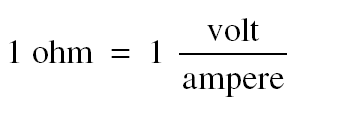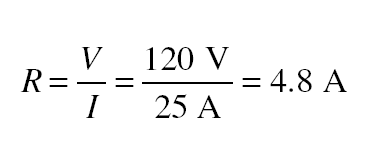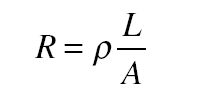Electric Current
In This Chapter:
✔ Electric Current
✔ Ohm’s Law
✔ Resistivity
✔ Electric Power
Electric Current
A flow of charge from one place to another constitutes an electric cur- rent. An electric circuit is a closed path in which an electric current carries energy from a source (such as a battery or generator), to a load (such as a motor or a lamp). In such a circuit (see Figure 12-1), electric current
Figure 12-1
is assumed to go from the positive terminal of the battery (or generator) through the circuit and back to the negative terminal of the battery. The direction of the current is conventionally considered to be that in which a positive charge would have to move to produce the same effects as the actual current. Thus a current is always supposed to go from the positive terminal of a battery to its negative terminal.
A conductor is a substance through which charge can flow easily, and an insulator is one through which charge can flow only with great difficulty. Metals, many liquids, and plasmas (gases whose molecules are charged) are conductors; nonmetallic solids, certain liquids, and gases whose molecules are electrically neutral are insulators.
Note!
A number of substances, called semiconductors, are intermediate in their ability to conduct charge.
Electric currents in metal wires always consist of flows of electrons; such currents are assumed to occur in the direction opposite to that in which the electrons move. Since a positive charge going one way is, for most purposes, equivalent to a negative charge going the other way, this assumption makes no practical difference. Both positive and negative charges move when a current is present in a liquid or gaseous conductor.
If an amount of charge q passes a given point in a conductor in the time interval t, the current in the conductor is
 The unit of electric current is the ampere (A), where
The unit of electric current is the ampere (A), where
For a current to exist in a conductor, there must be a potential difference between its ends, just as a difference in height between source and outlet is necessary for a river current to exist. In the case of a metallic conductor, the current is proportional to the
applied potential difference: Doubling V causes I to double, tripling V causes I to triple, and so forth. This relationship is known as Ohm’s law and is expressed in the form The quantity R is a constant for a given conductor and is called its resistance. The unit of resistance is the ohm (W), where
The quantity R is a constant for a given conductor and is called its resistance. The unit of resistance is the ohm (W), where
The greater the resistance of a conductor, the less the current when a certain potential difference is applied.
Ohm’s law is not a physical principle but is an experimental relationship that most metals obey over a wide range of values of V and I.
Solved Problem 12.1 A 120-V electric heater draws a current of 25 A. What is its resistance?
Solution.
Resistivity
The resistance of a conductor that obeys Ohm’s law is given by
where L is the length of the conductor, A is the cross-sectional area, and r (Greek letter rho), is the resistivity of the material of the conductor. In SI, the unit of resistivity is the ohm-meter.
The resistivities of most materials vary with temperature. If R is the resistance of a conductor at a particular temperature, then the change in its resistance DR when the temperature changes by DT is approximately proportional to both R and DT so that
The quantity a is the temperature coefficient of resistance of the material.
Electric Power
The rate at which work is done to maintain an electric current is given by the product of the current I and the potential difference V:
P = IV
Power = (current) (potential difference)
When I is in amperes and V is in volts, P will be in watts.
If the conductor or device through which a current passes obeys Ohm’s law, the power consumed may be expressed in the alternative forms
Table 12.1 is a summary of the various formulas for potential difference V, current I, resistance R, and power P that follow from Ohm’s law I = V/R and from the power formula P = VI.
Solved Problem 12.2 The current through a 50-W resistance is 2 A. How much power is dissipated as heat?
Table 12.1

![Electric Current ]_Page_083_Image_0001 Electric Current ]_Page_083_Image_0001](http://lh6.ggpht.com/-9W0OUa-c2UM/VE5iz0lUltI/AAAAAAAArk0/ZPIJkyi_XuM/Electric%252520Current%252520%25255D_Page_083_Image_0001_thumb.jpg?imgmax=800)


![Electric Current ]_Page_087_Image_0001 Electric Current ]_Page_087_Image_0001](http://lh3.ggpht.com/-fO8JDgsJ-t0/VE5jUSrjiRI/AAAAAAAArnU/cLnOIplJz2s/Electric%252520Current%252520%25255D_Page_087_Image_0001_thumb.jpg?imgmax=800)